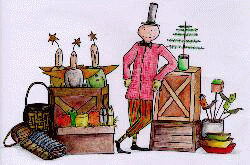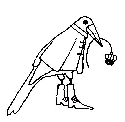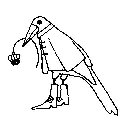
Homespun Peddler


|
The Best TIPS from 1997 |

|
these are highlights of tips that appeared in 1997 seed pod issues... we've tried to credit all tips but it wasn't possible in all cases...
thanks to all who shared these!
Maria
dye tips/tea dye
to make colors look more primitive or muted, dye them with black dye... some colors will deepen such as blue, purple and red. yellows and oranges will change to different colors... (cheryl)
dirtier-than-tea-dyed look
try two different things.rather than t-dyeing a piece of fabric that is too bright, only to get disappointing results, bleach first then t-dye. begins t-dye by boiling one quart of water to which you add one tablespoon of salt. (the salt allows the dye to be more permanent and more easily absorb into the fabric by activating the tannic acid in the tea) add about 12 tea bags to the water (fewer for lighter color) submerge the fabric until evenly saturated and allow to stew for 10 minutes,longer for deeper color. then rinse once with lukewarm water. (based on kindred spirits pattern booklet tip)
- After dipping fabric/project in tea, do not wring out and do not rinse. Take it outside, lay it down right-side up on an old towel, and let it sun dry. All the tea stain comes to the top of the fabric for a blotchy burnt kind of look.
- use a dark wood stain and streaked it on using a Q-tip. lynne
When dying fabrics try these for natural dyes: onion skins, (yellowish brown dye) blueberries, strawberries, beets or beet juice, and turmeric (the spice). carolyn p.
For a really an old, used,and abused look: Soak a few yards of muslin in hot water & add about 4-5 tablespoons of Gravy Master. Swish around. Drip dry outdoors. This gives the effect of a marbled water stain. Pam Smith
remember to use cotton thread if you plan to tea dye. polyester may repel dye and you could be left with a visible seam. rosalee
tin / rusting / metals / alternatives
rusting tin
light rusting: Pour APPLE CIDER (Must be APPLE CIDER) vinegar into an all-metal cookie sheet with sides. DO NOT use Teflon coated, enamelware, glass or plastic containers. Immerse tin into APPLE CIDER vinegar making sure the piece of tin is completely covered. Leave the tin in the vinegar for approximately 20 to 30 min. IT WILL NOT RUST IN THE PAN OF VINEGAR. Lift tin out of the vinegar and stand up on edge to dry. (Be sure to protect drying surface). DO NOT WIPE VINEGAR OFF. The tin will rust as it is air drying. The rusting could take 30 min to 3-4 hours (depending on the humidity). The longer you air dry, the more rusty it looks. When tin is completely dry, it will turn a copper color with uneven streaks and swirls.
Heavy Rusting: Must be done in a well ventilated area or outdoors. Use all metal cookie sheet with sides. DO NOT use teflon coated, enamelware, glass or plastic containers. Measure 2 cups of CLOROX or any household bleach and pour into metal cookie sheet with sides. Add 1 cup of APPLE CIDER vinegar and mix thoroughly. Immerse tin into solution. Tin has to be completely covered. It will start rusting immediately in the solution. It takes approx. 2-3 min. Lift out of solution and stand on edge to dry. It will become very rusty. Let air dry completely for approx. 1-3 hours or overnight. When it is completely dry some of the rust may be wiped off with a dry cloth.
aging copper
use liver of sulphur. it smells like rotten eggs but will give a nice blue-green patina to your copper cut outs. mary ellen
in place of Rusting Tin:
coat a piece of aluminum (which won't rust-but is easy to find and buy at hardware store) with a thin coat of Aleenes glue, let that dry, then paint over that, the paint adheres to it nicely. I usually paint first with black, then add dabs of browns to give a mottled rusty look... I even add cinnamon spice granules to the paint to give it a true "rusted" appearance. joanie
brown paper bag technique
(used to look like tin or other metal cut-outs) this technique was seen on aleene's crafts show/tnn network for more information contact aleenes crafts.if you miss a spot in burning, you can go over it with more glue and re-burn. It might take some practice getting used to the burning of the glue. depending on the colors of acrylic paint you use,it can look like rusted metal, tarnished gold or brass.
- glue 2 pieces of brown bag (grocery bag is fine) together with Aleenes glue in the gold bottle. let dry for 1/2 hour or so...
- cut the shape you want from this, spread one side with the glue, covering entire side, hold this side into a candle flame with a needle nose plyers. and let it burn... it will turn black and bubbly. this part is kind of tricky and could be dangerous USE CAUTION. Repeat for other side of shape.
- when finished with the burning, lightly rub off the soot with paper towel. then to achieve a burnished look, take gold paint on finger tip and lightly dab.
cinnamon cut outs
(DO NOT EAT)
Cinnamon Mixture:stir in applesauce and glue with cinnamon. work mixture with hand for 2-3 mins to form a ball. if too wet, add more cinnamon - if too dry, add more applesauce. knead the ball on a cinnamon-sprinkled surface surface until it holds together well. divide into 4 equal portions and roll out each 1/4" thick. cut dough with cookie cutters. place on cookie sheets or wire racks. use drinking straw to make a hole in top for hanging. air dry ornament. turn over from time to time to ensure even drying (takes approx. 24hours). for faster results, place in sunlight or dry in a warm oven (200 degrees) for an hour or less. rosetta
- 1/2 c. cinnamon
- 3/4 c. applesauce
- 2 Tbs tacky glue.
fabric stiffener/tea dye combo
when using items such as quilt scraps that need both stiffening and tea dye save time by mixing instant tea with the fabric stiffener and use a sponge brush to apply. (1 C. of stiffener and 3 tablespoons of instant tea). add a little water after mixing in the tea so it's not too thick. ~cheryl
felting wool
a simple process, to make wool that "acts" like felt. the finished product is often thicker and fluffier than actual polyester felt. it is more economical to felt the wool your self.
take the piece of 100% wool (this is the only kind that works properly) and put into boiling water or at least extremely hot. have a container with cold water and ice ready. remove the wool after a few minutes and shock it by putting into the cold ice water. next dry the wool in the clothes dryer. this process can be repeated if desired.
stencils and stenciling:
the technique is fairly simple... choose the paint that is right for the material you are stenciling. use the appropriate size stencil brush (these are the ones with short hairs that have a rounded tip,found in most craft stores). load the brush: dip in paint,use a circular motion on a piece of scrap paper or paper toweling to work the paint into the brush. do this until the paint appears to be all but faded,ie: no more paint coming onto the towel. then re-dip and do again to further load the color onto the brush. once the second dipping is not coming off onto the toweling your brush should be ready. it will look like there's no paint on it,but there is and the lightness of the paint gives a more dimensional effect.
once your brush is loaded place your stencil on the fabric or paper, you may want to secure with tape... then repeatedly tap the brush on the smooth,not coarse,side of the stencil. work the entire stencil,light colors first gradually moving to darker colors.
you can shade the stencil to give it further depth by keeping the shapes light in the center and darker on the bottom and edges. also use multiple colors in each color block rather than doing it as a "paint by number". gently remove the stencil and allow to dry. (use a different brush for each color)
you can also cut your own stencils with an exact-o type knife and a healing cutting surface. both are sold in art stores. the stencil material is usually sold in "blank" sheets that you can lay on top of the desired shape to trace with a permanent marker. draw and cut on the coarse side. you can do just about anything,and make multiple overlays if desired. (maria pahls)
tips from hickety pickety (sonja)
A few tips:
Any x-stitch pattern can easily be turned into a primitive stitchery by just tracin' around the design and of course not fillin' it in... just stitch it crudely.
Any muslin doll that is shown cutesy and not tea-dyed or anything can be easily be made primitive by painting the body, etc.....
Painting the clothing of a doll instead of always usin' printed boughten fabrics.
Stay away from usin' so much moss for the hair all the time, very hard to keep clean and this has been done so much that it's borin'...
You can paper mache anything!!! the easiest way to paper mache is usin' the celluclay from Wal MART that comes in a compressed block... mix with water and apply... the most important thing to remember when usin' this type of paper mache is that you HAVE to apply some type of glue to your item that you are gonna mache first... of course that is craft type glue NOT hot glue... if ya don't put the glue on first the paper mache will not stick... (apply mache over wet glue)... no need to put any finish on after ya paint it... I always like to apply some stain on mine tho to give it a more primitive crudy look... ya could put some spray matte sealer on it tho if ya wanted... the old fashioned type of paper mache is just strips of newspaper applied on with wall paper paste... much messier method and harder to work with I think... The paper mache method usin' the celluclay can be applied right over a muslin body... so any doll that ya made up as a plain muslin doll try puttin' paper mache over it's head, hands and feet!!!
patterns... everyone must utilize what patterns they have on hand... patterns are too expensive not to look at them differently... any wood pattern can usually be turned into cloth and vice-versa...
Just because you yourself loves primitives if you are doin' crafts for a livin', make one small area in your booth not so primitive, by that don't tea-dye some stuff quite so heavily, etc... a good business manager will always tell you that if you have a store, you better have some stuff in your shop that you personally don't like as well or you won't stay in business...
tips from donna o.
Quilts: I like to fade fabrics first by laying them in a sunny spot for a few weeks or leaving them on the clothes line, in most cases this works, but I recently bought a terrific pattern/ugly color for a wall hanging I want to make. It has been sitting in the sun for at least 6 months now and that sucker won't fade. I do have a fading kit from By Jupiter that I bought with the intention of fading reproduction fabric to repair antique quilts when authentic vintage fabric can not be found. I think I will have to resort to using it!
For wall hangings I prefer to not pre-wash the fabric or the cotton batting, and use a tan Rit brand dye to over dye the finished quilt. By not pre-washing the batting or fabric I can get a little bit of a pucker from the shrinkage that helps to add to the aged look.
For mild staining for dolls or ornaments I put my fabrics in a vat of tea and stir. If I want defined stains I do not stir while tea dying.
For staining a finished doll (such as I do when someone gives me a doll as a gift) I wet a tea bag and slap the doll silly, this does give a blotchy look in some places. NOTE: if you get the doll too wet it will drip down to the back of the doll (assuming you lay it flat to dry) and then there will be big ugly bloches on the back. It is best with this method to dab the doll with a damp tea bag and let it dry. Then if it is not stained enough do it again.
For a really wicked staining, lay your wet fabric/quilt flat - you will probably want to have plastic wrap under it to protect your work surface - and open a tea bag and sprinkle the tea around on the fabric, used coffee grounds will work for this too.
Another thing I have discovered, adding a bit of cinnamon to the water when steeping tea gives a nice warm color. You have to rinse off the specks of cinnamon when you are all done staining - but it sure smells great while you are working!!!
I have also heard of making tea and putting it in a spray bottle, but I have tried this once and was not happy with the results, I prefer to use a damp tea bag.
thanks carolyn for this tip: sheets of mylar ( what quilters use for making quilt pattern templates and the material stencils are cut from) can be used to trace and cut out pattern templates- they last forever
Main Page gallery Index
All rights reserved. No part of this pattern or web page may be reproduced without written permission from the publisher. nor may any part of this newsletter be reproduced, stored in a retrieval system, or transmitted in any form or by any means -- electronic, mechanical, photo- copying, recording, or other -- without written permission from the publisher.
Permission is granted to individuals to print these tips for personal use and for limited distribution to friends. No mass copying and no re-sale or other commercial use is allowed.
Published to the internet by arrangement with Homespun Peddler.
For more information send e-mail to the Peddler.
v201.0
HOME PAGE
CONTENTS
Site designed by OJ Advertising, Inc.
Site developed and maintained by MMCC, Inc.
Report problems or suggestions to support@mmcctech.com
Jackie Gannaway Cookbook Cupboard Index.